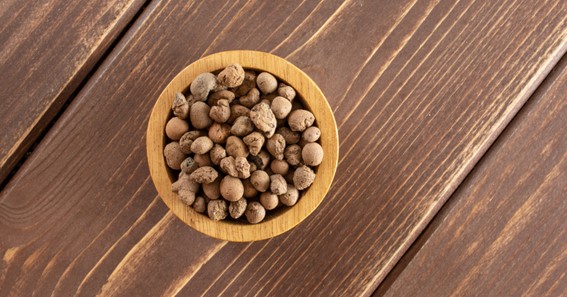Are you curious to know what is leca? You have come to the right place as I am going to tell you everything about leca in a very simple explanation. Without further discussion let’s begin to know what is leca?
In the world of horticulture and hydroponics, finding the perfect growing medium is essential for fostering healthy plant growth. While traditional options like soil have been used for centuries, modern gardening has embraced innovative alternatives. One such groundbreaking medium that has gained popularity in recent years is Leca. In this blog post, we will explore what Leca is, its unique properties, and why it has become a favorite among gardeners and plant enthusiasts alike.
What Is Leca?
Leca, an acronym for Lightweight Expanded Clay Aggregate, is a remarkable growing medium made from 100% natural clay. The process of creating Leca involves heating small clay pellets in a rotary kiln at high temperatures, causing them to expand and become porous. The result is a lightweight, inert, and sterile medium with numerous benefits for plant cultivation.
The Unique Properties Of Leca
- Lightweight: One of the primary advantages of Leca is its lightweight nature, making it easy to handle and transport. This attribute is particularly valuable for rooftop gardens, hanging planters, and other situations where traditional heavy soil might not be suitable.
- Porous Structure: Leca pellets possess a porous structure with tiny air pockets, providing excellent aeration to the plant roots. This aeration enhances oxygen availability and prevents waterlogged conditions, ensuring healthy root development and reducing the risk of root rot.
- pH Neutral: Leca is pH neutral, meaning it does not alter the pH levels of the surrounding environment. This feature grants gardeners greater control over the nutrient solution, allowing them to adjust and optimize the pH to suit specific plant requirements.
- Non-Decomposable: Unlike organic mediums such as soil, Leca is non-decomposable. This characteristic ensures its longevity and resistance to compaction, enabling consistent drainage and root aeration throughout the plant’s growth cycle.
- Reusable: Leca can be reused multiple times, making it an eco-friendly choice for environmentally conscious gardeners. After a growing season, simply sterilize the pellets and use them again for new plants, reducing waste and overall costs.
Uses Of Leca
Leca has found widespread application in various gardening and hydroponic systems, including:
- Hydroponics: Leca is widely used in hydroponic systems where plants grow without soil, receiving nutrients through a water-based solution. Its porous structure facilitates optimal root oxygenation and nutrient absorption.
- Container Gardening: Leca is an excellent choice for container gardening due to its lightweight properties. It allows for better drainage and aeration in confined spaces, promoting healthier root systems.
- Green Roofs: Leca is a favored medium for green roofs as its light weight minimizes structural stress. Its excellent drainage capabilities prevent water buildup and potential roof damage.
Conclusion
Leca, the Lightweight Expanded Clay Aggregate, has revolutionized modern gardening practices. Its unique properties of lightweight, porosity, and reusability have made it a go-to growing medium for hydroponics, container gardening, and green roofs. As more gardeners and plant enthusiasts explore sustainable and efficient gardening methods, Leca continues to emerge as a reliable and eco-friendly choice.
Whether you’re a seasoned horticulturist or a budding plant enthusiast, consider giving Leca a try in your gardening endeavors. Its versatility and numerous benefits may just be the key to unlocking your garden’s full potential. Embrace innovation, sustainability, and growth with Leca, and watch your plants thrive like never before.
Get more information about cast on Starcasto
FAQ
What Does Leca Do For Plants?
Using LECA provides space for oxygen to flow through to the plant’s roots, botanist Rosie Yee explains. “Plants don’t have a pump in their body like we do,” she says. “They have to absorb oxygen through their roots [and so] LECA provides pockets of airflow around the roots.”
Is Leca Better Than Soil?
Unlike soil, LECA is a lot less messy than soil and is naturally neutral, making it a great substrate for indoor plants. These clay pebbles can provide an ideal balance of moisture, food and air for your indoor plants. Keep in mind however, that unlike soil (which is fully organic), LECA does not contain nutrients.
What Is Leca And How Does It Work?
Leca is a type of clay that has been heated and expanded to create lightweight, porous pellets. These pellets can then be used in place of soil to support plant roots. Unlike soil, Leca does not require watering or fertilizing, and it is also resistant to pests and diseases.
What Are Leca Balls Made Of?
LECA stands for ‘lightweight expanded clay aggregate,’ and is made from clay, brick dust, and waste from the processing of albite (a sodium-rich mineral derived from feldspar). The primary use of the clay balls is as a substrate in hydroponic growing.
I Have Covered All The Following Queries And Topics In The Above Article
What Is Leca
What Is Leca For Plants
What Is Leca Balls
What Is Leca?
What Is Leca Made Of
What Is Leca Used For
What Is Leca Plants
Leca What Is It
What Is Leca Clay Balls
What Is Dolca Leca
What Is Leca Clay Orchid Vs Rockplug
What Is Leca Evolution
What Is Leca Good For
What Is Leca Clay Orchid For
What Is Leca Soil
What Is Leca Hydroponic
What Is The Orchid Potting Medium Called Leca
What Is Leca Digicopy
What Is Leca For
What Is In The Center Of Leca Beads
What Is The Leca Organism
What Is Leca
What does LECA do for plants
